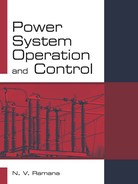1.3 OBJECTIVE FUNCTION AND CONSTRAINTS FOR THE ECONOMIC DISPATCH PROBLEM
As discussed earlier, the ED problem deals with the optimal allocation of total load demand PD amongst n-number of units. The objective function for the ED problem is presented below.
The problem is to minimize the function Eq.(1.3) subject to the satisfaction of constraints.
where CTotal is the total cost of generation and PG1, PG2,…, PGn are individual generations of n-number of units. The ED problem may be treated as parameter (cost) optimization subject to the satisfaction of system constraints. System constraints are of two types:
- equality constraints,
- inequality constraints.
Equality constraints
These constraints are due to functional dependencies. Let f and g have functional dependencies and the problem is to minimize the function f (x1, x2, x3), where x1, x2, x3 are variables whose values are computed such that the given function f is minimized. The computed values of x1, x2, and x3 are said to be optimal when they minimize both the function f and satisfy the following equality constraints which are described by a set of equations:
In the ED problem, the equality constraint functional dependency equations are static power flow equations. For optimized scheduling of generation cost for the given demand, there is a necessity for static power flow equations to be satisfied. The other equality constraint is that sum of power generation by individual units must be equal to the total power demand as:
or
Inequality constraints
The following inequality constraints may be included in the ED problem.
- Each generating unit of a given n number must operate at a limit equal to, or below and above its maximum and minimum limits respectively.
Pimin ≤ Pi ≤ Pimax i = 1, 2, … , n. (1.6)
- Reactive power (Q) generated by individual generating units should be less than the maximum value to avoid rotor over-heating and should be more than minimum value to ensure optimal power transfer capability of the system.
- Total MVA rating of individual units, to ensure there is no excess heating produced in the unit.
- Over-loading condition of equipment like transformers and lines.
- Limits to voltage magnitudes and angles to ensure that the system has better stability margins. Low voltage gives rise to instability and unsatisfactory operation of loads dominated by induction motor type. High voltage problems shall lead to insulation breakdowns.
- Transformer tap positions: The tap position should be between the minimum and maximum values.
- Reserve capacities of generating units: To meet the sudden increase of power demand and to maintain good steady-state stability of the system.
The above constraints are basically control parameters, which are required to be within their limits for satisfactory operation of the power system. Though the primary interest is minimization of objective functions, owing to operational limitations these constraints are important and hence must be included in the study.
